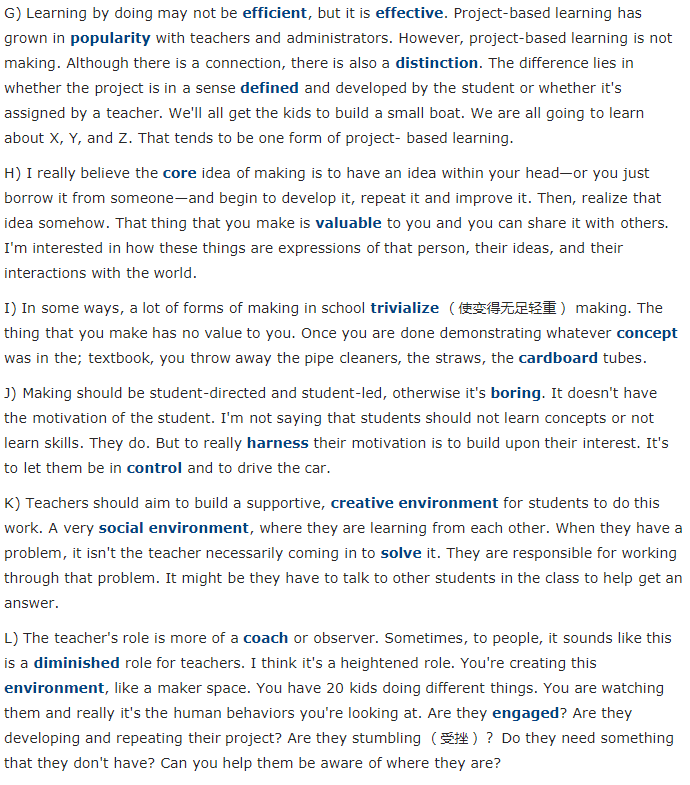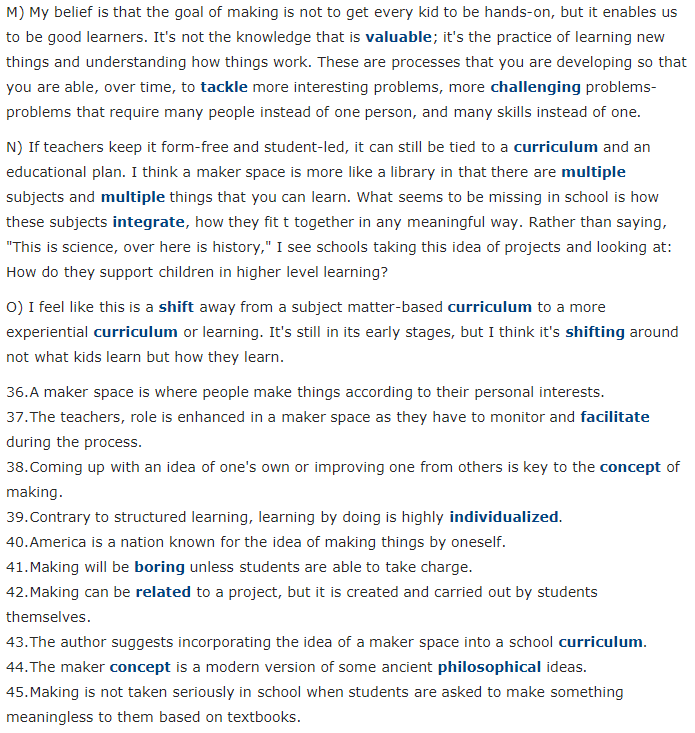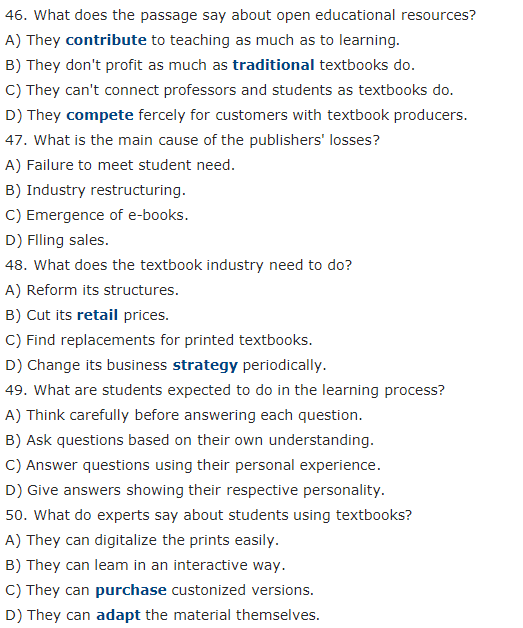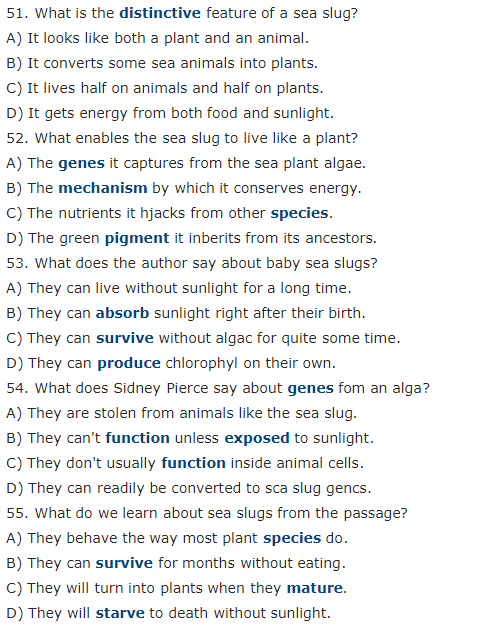A) We've always been a hands-on, do it-yourself kind of nation. Ben Franklin, one of America's founding fathers, didn't just invent the lightning rod. His creations include glasses, innovative stoves and more.
B) Franklin, who was largely self-taught, may have been a genius, but he wasn't really an exception when it comes to American making and creativity.
C) The personal computing revolution and philosophy of disruptive innovation of Silicon Valley grew, in part, out of the creations of the Homebrew Computer Club, which was founded in a garage in Menlo Park, California, in the mid-1970s. Members-including guys named Jobs and Wozniak-started making and inventing things they couldn't buy.
D) So it's no surprise that the Maker Movement today is thriving in communities and some schools across America. Making is available to ordinary people who aren't tied to big companies, big defense labs or research universities. The maker philosophy echoes old ideas advocated by John Dewey, Montessori, and even ancient Greek philosophers, as we pointed out recently.
E) These maker spaces are often outside of classrooms, and are serving an important educational function. The Maker Movement is rediscovering learning by doing, which is Dewey's phrase from 100 years ago. We are rediscovering Dewey and Montessori and a lot of the practices that they pioneered that have been forgotten or at least put aside. A maker space is a place which can be in a school, but it doesn't look like a classroom. It can be in a library. It can be out in the community. It has tools and materials. It's a place where you get to make things based on your interest and on what you, re learning to do.
F) Ideas about learning by doing have struggled to become mainstream educationally, despite being old concepts from Dewey and Montessori, Plato and Aristotle, and in the American context, Ralph Emerson, on the value of experience and self-reliance. It's not necessarily an efficient way to learn. We learn, in a sense, by trial and error. Learning from experience is something that takes time and patience. It's very individualized. If your goal is to have standardized approaches to learning, where everybody learns the same thing at the same time in the same way, then learning by doing doesn't really fit that mold anymore. It's not the world of textbooks. It's not the world of testing.


正确答案及解析
正确答案
36-45:EICGK FBJDH
解析
36.创客空间是人们根据个人兴趣制造东西的地方。
37.教师在创客空间中的角色得到加强,因为他们必须在这个过程中进行监督和促进。
38.想出一个自己的想法或者从别人那里改进一个想法是制造概念的关键。
39.与结构化学习相反,边做边学是高度个性化的。
40.美国是一个以自己制造东西而闻名的国家。
41.除非学生们能掌控一切,否则制作将是乏味的。
42.制作可以与一个项目相关,但它是由学生自己创建和执行的。
43.作者建议将创客空间的理念纳入学校课程。
44.创客概念是一些古代哲学思想的现代版本。
45.在学校里,当学生被要求根据教科书做一些对他们来说毫无意义的东西时,制作并没有受到重视。
你可能感兴趣的试题
Textbooks represent an 11 billion dollar industry, up from $8 billion in 2014. Textbook publisher Pearson is the largest publisher -- of any kind -- in the world.
It costs about $1 million to create a new textbook. A freshman textbook will have dozens of contributors, from subject-matter experts through graphic and layout artists to expert reviewers and classroom testers. Textbook publishers connect professors, instructors and students in ways that alternatives, such as open e-textbooks and open educational resources, simply do not. This connection happens not only by means of collaborative development, review and testing, but also at conferences where faculty regularly decide on their textbooks and curricula for the coming year.
It is true that textbook publishers have recently reported losses, largely due to students renting or buying used print textbooks. But this can be chalked up to the excessively high cost of their books -- which has increased over 1,000 percent since 1977. A restructuring of the textbook industry may well be in order. But this does not mean the end of the textbook itself.
While they may not be as dynamic as an iPad, textbooks are not passive or lifeless. For example, over the centuries, they have simulated (模拟) dialogues in a number of ways. From 1800 to the present day, textbooks have done this by posing questions for students to answer inductively (归纳性地). That means students are asked to use their individual experience to come up with answers to general questions. Today's psychology texts, for example, ask: "How much of your personality do you think you inherited?" while ones in physics say: "How can you predict where the ball you tossed will land?"
Experts observe that "textbooks come in layers, something like an onion." For an active learner, engaging with a textbook can be an interactive experience. Readers proceed at their own pace. They "customize" their books by engaging with different layers and linkages. Highlighting, Post-It notes, dog-ears and other techniques allow for further customization that students value in print books over digital forms of books.

- 查看答案
When we think of animals and plants, we have a pretty good way of dividing them into two distinct groups: one converts sunlight into energy and the other has to eat food to make its energy. Well, those dividing lines come crashing down with the discovery of a sea slug (海蛞蝓) that's truly half animal and half plant. It's pretty incredible how it has managed to hijack the genes of the algae (藻类) on which it feeds.
The slugs can manufacture chlorophyll, the green pigment (色素) in plants that captures energy from sunlight, and hold these genes within their body. The term kleptoplasty is used to describe the practice of using hijacked genes to create nutrients from sunlight. And so far, this green sea slug is the only known animal that can be truly considered solar-powered, although some animals do exhibit some plant-like behaviors. Many scientists have studied the green sea slugs to confirm that they are actually able to create energy from sunlight.
In fact, the slugs use the genetic material so well that they pass it on to their future generations. Their babies retain the ability to produce their own chlorophyll, though they can't generate energy from sunlight until they've eaten enough algae to steal the necessary genes, which they can't yet produce on their own.
"There's no way on earth that genes from an alga should work inside an animal cell," says Sidney Pierce from the University of South Florida. "And yet here, they do. They allow the animal to rely on sunshine for its nutrition. So if something happens to their food source, they have a way of not starving to death until they find more algae to eat."
The sea slugs are so good at gathering energy from the sun that they can live up to nine months without having to eat any food. They get all their nutritional needs met by the genes that they've hijacked from the algae.

- 查看答案
For this part, you are allowed 30 minutes to write a letter to a foreign friend who wants to teach English in China. Please recommend a city to him. You should write at least 120 words but no more than 180 words.
- 查看答案
Directions: For this part, you are allowed 30 minutes to write a letter to a foreign friend who wants to study in China. Please recommend a university to him. You should write at least 120 words but no more than 180 words.
- 查看答案
Directions: For this part, you are allowed 30 minutes to write a letter to a foreign friend who wants to teach English. Please recommend a city to him. You should write at least 120 words but no more than 180 words.
- 查看答案